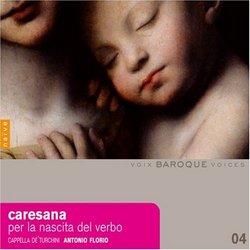Deep Roots: Popular Music of baroque Naples
Giordano Bruno | Wherever I am, I am. | 10/21/2009
(5 out of 5 stars)
"Christofaro Caresana ( 1640-1709) moved from Venice to Naples at age 16 and spent the rest of his life composing music chiefly for popular festivals - music performed for and by the most ordinary people of Naples, both in the streets and in churches. His compositions are easily the most numerous in the vast collection of festival cantatas and incidental music in the archives of the Filippini di Napoli, founded by saint Filippo Neri as the Counterreformation's 'outreach' to the populace. No better example could be found, I think, of the deep roots of baroque cantatas and operas in the broad popular appreciation of skillful composition in the 17th and 18th Centuries. Caresana's music - his joyful ritornelli, his dramatic recitativos - are thoroughly based in the 'prima prattica' of Monteverdi and other better-known composers; one might almost risk the question of whether the baroque manner influenced later popular taste, or whether earlier popular styles from southern Italy weren't subsumed in the works of the composers who worked for aristocratic circles.
All three of the cantatas by Caresana on this CD were commissioned for and performed at massive popular celebrations of the Nativity. Neapolitan Christmas was not much like modern American; no Santa, no decorated tree, no shopping mall splurges, no sleigh bells, and no electrified Bing Crosby. The Hunting of the Bull is in fact a Nativity parable, a syncretic mash-up of astrology and theology in which Humility slays the Bull of prideful sin and welcomes the Christ Child. La Tarantella is equally syncretic, a blend of shepherd's dancing and a confrontation with Pluto, the Lord of Death, all based on ancient folk-medicine notions of poisons and antidotes. La Pastorella, based on the recurrent chaconne basso chordal figure, also depicts a victory of the Child and saint Michael over Lucifer and his demons. Rousing, exuberant music! Spectacle! Voices and instruments swirling in the throngs! And all composed with the highest finesse.
The instrumental ensemble "Cappella della Pieta de' Turchini" might sound like a dark horse, but soprano Roberta Invernizzi and basso Furio Zanasi are deservedly well-known baroque headliners. Zanasi has the perfect robust basso for this music, a voice that could stir the throngs of peasants and yet delight the Cardinals and their entourage in the gallery. Tenors Giuseppe De Vittorio and Rosario Totaro have that ringing "Pavarotti" warmth of the Italian serenade. Roberta Invernizzi and Roberta Andalo sing angelically, and that dark horse ensemble - violins, gamba,cello, recorders, bassoon, double harp, theorbo, clavicembalo, organ, and "calascione" - performs impeccably. This is a convincing performance all around, of a repertoire that was fundamental to the developing history of baroque music and of music as a public performance art rather than an adjunct to clerical elitism. And it's got zest! Abbondanza! Alegría!"

